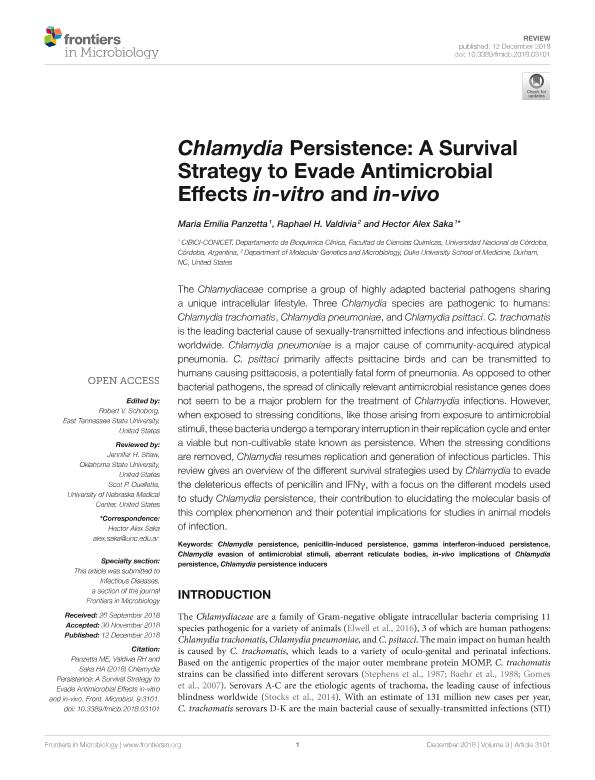Mostrar el registro sencillo del ítem
dc.contributor.author
Panzetta, Maria Emilia

dc.contributor.author
Valdivia, Raphael H.
dc.contributor.author
Saka, Hector Alex

dc.date.available
2020-01-27T19:22:03Z
dc.date.issued
2018-12
dc.identifier.citation
Panzetta, Maria Emilia; Valdivia, Raphael H.; Saka, Hector Alex; Chlamydia Persistence: A Survival Strategy to Evade Antimicrobial Effects in-vitro and in-vivo; Frontiers Media S.A.; Frontiers in Microbiology; 9; 12-2018; 1-11
dc.identifier.issn
1664-302X
dc.identifier.uri
http://hdl.handle.net/11336/95887
dc.description.abstract
The Chlamydiaceae comprise a group of highly adapted bacterial pathogens sharing a unique intracellular lifestyle. Three Chlamydia species are pathogenic to humans: Chlamydia trachomatis, Chlamydia pneumoniae, and Chlamydia psittaci. C. trachomatis is the leading bacterial cause of sexually-transmitted infections and infectious blindness worldwide. Chlamydia pneumoniae is a major cause of community-acquired atypical pneumonia. C. psittaci primarily affects psittacine birds and can be transmitted to humans causing psittacosis, a potentially fatal form of pneumonia. As opposed to other bacterial pathogens, the spread of clinically relevant antimicrobial resistance genes does not seem to be a major problem for the treatment of Chlamydia infections. However, when exposed to stressing conditions, like those arising from exposure to antimicrobial stimuli, these bacteria undergo a temporary interruption in their replication cycle and enter a viable but non-cultivable state known as persistence. When the stressing conditions are removed, Chlamydia resumes replication and generation of infectious particles. This review gives an overview of the different survival strategies used by Chlamydia to evade the deleterious effects of penicillin and IFNγ, with a focus on the different models used to study Chlamydia persistence, their contribution to elucidating the molecular basis of this complex phenomenon and their potential implications for studies in animal models of infection.
dc.format
application/pdf
dc.language.iso
eng
dc.publisher
Frontiers Media S.A.

dc.rights
info:eu-repo/semantics/openAccess
dc.rights.uri
https://creativecommons.org/licenses/by/2.5/ar/
dc.subject
ABERRANT RETICULATE BODIES
dc.subject
CHLAMYDIA EVASION OF ANTIMICROBIAL STIMULI
dc.subject
CHLAMYDIA PERSISTENCE
dc.subject
CHLAMYDIA PERSISTENCE INDUCERS
dc.subject
GAMMA INTERFERON-INDUCED PERSISTENCE
dc.subject
IN-VIVO IMPLICATIONS OF CHLAMYDIA PERSISTENCE
dc.subject
PENICILLIN-INDUCED PERSISTENCE
dc.subject.classification
Biología Celular, Microbiología

dc.subject.classification
Ciencias Biológicas

dc.subject.classification
CIENCIAS NATURALES Y EXACTAS

dc.title
Chlamydia Persistence: A Survival Strategy to Evade Antimicrobial Effects in-vitro and in-vivo
dc.type
info:eu-repo/semantics/article
dc.type
info:ar-repo/semantics/artículo
dc.type
info:eu-repo/semantics/publishedVersion
dc.date.updated
2019-10-22T16:34:21Z
dc.journal.volume
9
dc.journal.pagination
1-11
dc.journal.pais
Suiza

dc.journal.ciudad
Lausana
dc.description.fil
Fil: Panzetta, Maria Emilia. Consejo Nacional de Investigaciones Científicas y Técnicas. Centro Científico Tecnológico Córdoba. Centro de Investigaciones en Bioquímica Clínica e Inmunología; Argentina
dc.description.fil
Fil: Valdivia, Raphael H.. University of Duke; Estados Unidos
dc.description.fil
Fil: Saka, Hector Alex. Consejo Nacional de Investigaciones Científicas y Técnicas. Centro Científico Tecnológico Córdoba. Centro de Investigaciones en Bioquímica Clínica e Inmunología; Argentina
dc.journal.title
Frontiers in Microbiology
dc.relation.alternativeid
info:eu-repo/semantics/altIdentifier/url/https://www.frontiersin.org/articles/10.3389/fmicb.2018.03101/full
dc.relation.alternativeid
info:eu-repo/semantics/altIdentifier/doi/https://doi.org/10.3389/fmicb.2018.03101
Archivos asociados
